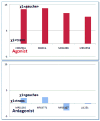Predicted structures of agonist and antagonist bound complexes of adenosine A3 receptor
- PMID: 21488099
- PMCID: PMC3092833
- DOI: 10.1002/prot.23012
Predicted structures of agonist and antagonist bound complexes of adenosine A3 receptor
Abstract
We used the GEnSeMBLE Monte Carlo method to predict ensemble of the 20 best packings (helix rotations and tilts) based on the neutral total energy (E) from a vast number (10 trillion) of potential packings for each of the four subtypes of the adenosine G protein-coupled receptors (GPCRs), which are involved in many cytoprotective functions. We then used the DarwinDock Monte Carlo methods to predict the binding pose for the human A(3) adenosine receptor (hAA(3)R) for subtype selective agonists and antagonists. We found that all four A(3) agonists stabilize the 15th lowest conformation of apo-hAA(3)R while also binding strongly to the 1st and 3rd. In contrast the four A(3) antagonists stabilize the 2nd or 3rd lowest conformation. These results show that different ligands can stabilize different GPCR conformations, which will likely affect function, complicating the design of functionally unique ligands. Interestingly all agonists lead to a trans χ1 angle for W6.48 that experiments on other GPCRs associate with G-protein activation while all 20 apo-AA(3)R conformations have a W6.48 gauche+ χ1 angle associated experimentally with inactive GPCRs for other systems. Thus docking calculations have identified critical ligand-GPCR structures involved with activation. We found that the predicted binding site for selective agonist Cl-IB-MECA to the predicted structure of hAA(3)R shows favorable interactions to three subtype variable residues, I253(6.58), V169(EL2), and Q167(EL2), while the predicted structure for hAA(2A)R shows weakened to the corresponding amino acids: T256(6.58), E169(EL2), and L167(EL2), explaining the observed subtype selectivity.
Copyright © 2011 Wiley-Liss, Inc.
Figures








Similar articles
-
Docking studies of agonists and antagonists suggest an activation pathway of the A3 adenosine receptor.J Mol Graph Model. 2006 Dec;25(4):562-77. doi: 10.1016/j.jmgm.2006.05.004. Epub 2006 May 9. J Mol Graph Model. 2006. PMID: 16793299 Free PMC article.
-
Topological sub-structural molecular design (TOPS-MODE): a useful tool to explore key fragments of human A3 adenosine receptor ligands.Mol Divers. 2016 Feb;20(1):55-76. doi: 10.1007/s11030-015-9617-z. Epub 2015 Jul 24. Mol Divers. 2016. PMID: 26205409
-
Subtle Chemical Changes Cross the Boundary between Agonist and Antagonist: New A3 Adenosine Receptor Homology Models and Structural Network Analysis Can Predict This Boundary.J Med Chem. 2021 Sep 9;64(17):12525-12536. doi: 10.1021/acs.jmedchem.1c00239. Epub 2021 Aug 26. J Med Chem. 2021. PMID: 34435786 Free PMC article.
-
Structural Probing and Molecular Modeling of the A₃ Adenosine Receptor: A Focus on Agonist Binding.Molecules. 2017 Mar 11;22(3):449. doi: 10.3390/molecules22030449. Molecules. 2017. PMID: 28287473 Free PMC article. Review.
-
Medicinal chemistry of A₃ adenosine receptor modulators: pharmacological activities and therapeutic implications.J Med Chem. 2012 Jun 28;55(12):5676-703. doi: 10.1021/jm300087j. Epub 2012 Apr 17. J Med Chem. 2012. PMID: 22468757 Review. No abstract available.
Cited by
-
Predicted 3D structures of olfactory receptors with details of odorant binding to OR1G1.J Comput Aided Mol Des. 2014 Dec;28(12):1175-90. doi: 10.1007/s10822-014-9793-4. Epub 2014 Sep 16. J Comput Aided Mol Des. 2014. PMID: 25224127
-
Predicting glycosaminoglycan surface protein interactions and implications for studying axonal growth.Proc Natl Acad Sci U S A. 2017 Dec 26;114(52):13697-13702. doi: 10.1073/pnas.1715093115. Epub 2017 Dec 11. Proc Natl Acad Sci U S A. 2017. PMID: 29229841 Free PMC article.
-
Conformational and Thermodynamic Landscape of GPCR Activation from Theory and Computation.Biophys J. 2016 Jun 21;110(12):2618-2629. doi: 10.1016/j.bpj.2016.04.028. Biophys J. 2016. PMID: 27332120 Free PMC article.
-
Steviol rebaudiosides bind to four different sites of the human sweet taste receptor (T1R2/T1R3) complex explaining confusing experiments.Commun Chem. 2024 Oct 18;7(1):236. doi: 10.1038/s42004-024-01324-x. Commun Chem. 2024. PMID: 39424933 Free PMC article.
-
Development of enhanced conformational sampling methods to probe the activation landscape of GPCRs.Adv Protein Chem Struct Biol. 2022;128:325-359. doi: 10.1016/bs.apcsb.2021.11.001. Epub 2021 Dec 20. Adv Protein Chem Struct Biol. 2022. PMID: 35034722 Free PMC article. Review.
References
-
- Vu CB, Shields P, Peng B, Kumaravel G, Jin X, Phadke D, Wang J, Engber T, Ayyub E, Petter RC. Triamino derivatives of triazolotriazine and triazolopyrimidine as adenosine A2A receptor antagonists. Bioorg Med Chem Lett. 2004;14:4835–4838. - PubMed
-
- Tracey WR, Magee WP, Oleynek JJ, Hill RJ, Smith AH, Flynn DM, Knight DR. Novel N6-substituted adenosine 5’-N-methyluronamides with high selectivity for human adenosine A3 receptors reduce ischemic myocardial injury. Am J Physiol Heart Circ Physiol. 2003;285:H2780–2787. - PubMed
Publication types
MeSH terms
Substances
Grants and funding
LinkOut - more resources
Full Text Sources
Other Literature Sources

